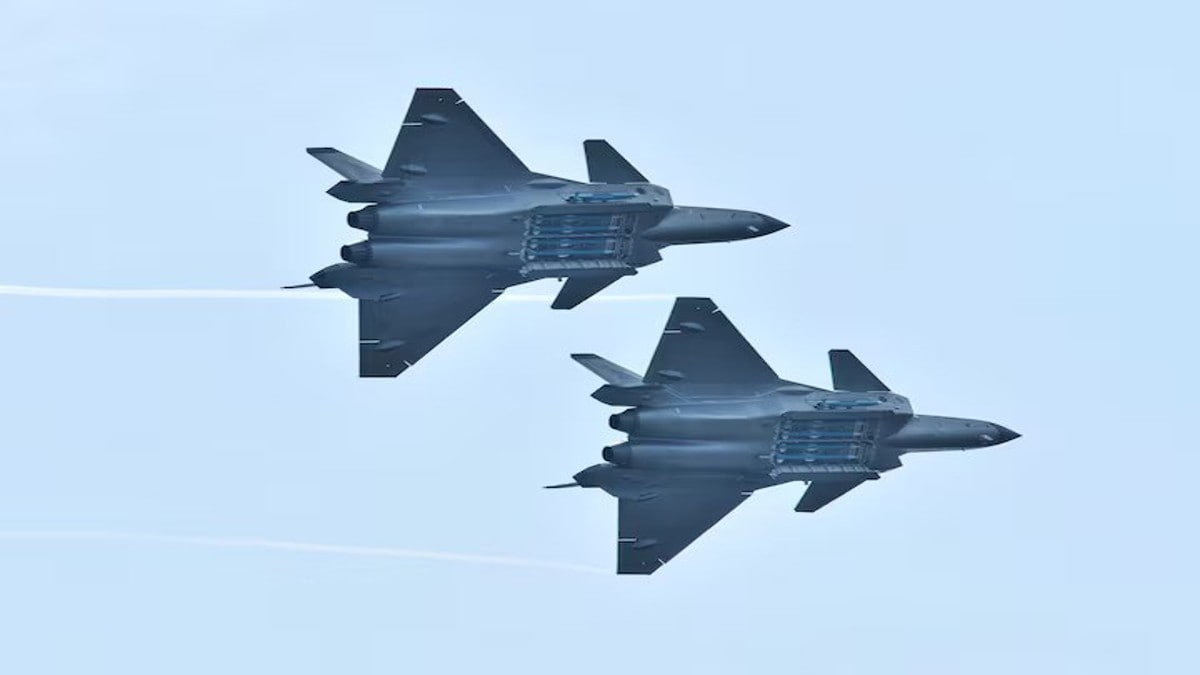
India-China relations have been at lows since the Galwan skirmish four years ago. There is an uneasy calm at present and an attempt to re-engage, but a range of divergences persist between the two Asian giants. China is aggressively building infrastructure in Tibet and Xinjiang along the Line of Actual Control (LAC).
The Chinese want to add air power to the conflict. China’s People’s Liberation Army Air Force (PLAAF) recently deployed fifth-generation stealth fighters J-20 at Shigatse Air Base around 300 kilometres north of the Indian Air Force’s (IAF) Rafale air base at Hasimara and just 150 km from the LAC in Sikkim. J-20s have operated at Hotan Airbase in Xinjiang, 350 km north of Pangong Tso Lake.

And just 120 km from India’s claim line in Aksai Chin. It is important to understand the PLAAF resources and capabilities at these two operationally important airbases. Shigatse (Xigaze) Air Base Shigatse (Xigaze) is the second largest city in Tibet Autonomous Region.
Shigatse Airbase, also called the Shigatse Peace Airport, is a dual-use airfield in Tibet, around 180 kilometres west of Lhasa. Construction began in 1968 and was completed in 1973. PLAAF started operating there in 1973, and civil operations began in 2010.
The airport is at an elevation of 3,782 m / 12,408 ft above mean sea level (AMSL) and is one of the highest airports in the world. It has two concrete runways, 09/27 with 5,000 m (16,404 ft) length, and the second, 07/25 with 3,000 m (9,843 ft) length. It has the longest public runway in the world; the only other with the same length is Ulyanovsk Vostochny Airport in south-west Russia.
The airport sees over 2,000 movements a year and around 200,000 passengers. Significant cargo is also transported by air. The second (shorter) runway was constructed in 2017, and Guizhou WZ-7 “Soaring Dragon” UAVs were seen operating from here.
In May 2024, six J-20 stealth fighters were seen operating from the airbase. Also, at least eight J-10 aircraft and one KJ-500 Airborne Early Warning and Control (AEW&C) aircraft were seen parked at the airbase. The runway at Shigatse is very large, and therefore it will be able to partially neutralise the disadvantage of weight carriage during high-altitude airfield operations.
The Chengdu J-20 ‘Mighty Dragon’ The Chengdu J-20 is the Chinese twinjet stealth fifth-generation fighter aircraft. The aircraft has three variants: the initial production model J-20A, the thrust-vectoring J-20B, and the twin-seat aircraft teaming capable J-20S. The aircraft made its first flight in January 2011, and the first J-20 combat unit was formed in February 2018, making China the second country in the world and the first in Asia to field an operational stealth aircraft.
Nearly 250 have been built as of date. J-20 squadrons have been allotted to all the theatre commands. The aircraft has the Type 1475 (KLJ-5) active electronically scanned array (AESA) radar.
Six electro-optic sensors provide omnidirectional IR coverage, which is fused with the radar picture for better situational awareness. The aircraft is powered by a Chinese WS-10Cs engine with thrust of 142-147 kN and has serrated afterburner nozzles for enhanced rear-aspect stealth. The finally intended powerplant is the Shenyang WS-15 with a thrust of 180 kN.
The main weapon bay is capable of housing both long-range air-to-air missiles (PL-12, PL-15, PL-21) and precision-guided munitions. The two smaller lateral weapon bays can carry short-range AAMs (PL-10). The estimated production rate was 40 to 50 airframes per year in 2022 and 100 to 120 airframes per year in 2023.
PLA Air Force (PLAAF) currently has around 240 aircraft. The J-20 fleet could reach 1,000 aircraft by the early 2030s. J-20S will be a twin-seat variant.
The second operator to coordinate attack and reconnaissance missions and manage unmanned combat aerial vehicles (UCAVs) as “loyal wingmen” such as the AVIC Dark Sword and stealth Hongdu GJ-11 UCAV. Significance of Deployment at Shigatse Shigatse is rather close to LAC near Sikkim (150 km) and IAF’s Hasimara air base (300 km). Hasimara air base is in the Siliguri corridor, known as the Chicken’s Neck.
It is a stretch of land, 20–22 kilometres at the narrowest section. This geopolitical and geoeconomic corridor connects the seven northeastern states to the rest of India. The airbase is very significant as it houses one of the only two squadrons of the top-end IAF aircraft, the Rafale.
If this base was to be neutralised even for short periods, it would have implications for India. If an unfriendly regime takes charge in Bangladesh, the complexity of the narrow Siliguri corridor increases. But then India has lived with much more hostile East Pakistan.
Today, India is a much more powerful country, but so is China. J-20 vs Rafale The Indian Rafale is a 4.5-generation aircraft with front-hemisphere stealth.
It is much better than J-20 in terms of weapons, electronic warfare, and aero-engine reliability. The J-20 has yet to leave its shores, even for an airshow. It has no combat experience.
It has yet to exercise with any foreign air force. Rafale has been combat-proven for 20 years in Iraq, Afghanistan, Mali, Libya, and Syria. IAF regularly exercises them with the top air forces of the world, most recently in “Red Flag” (USA) and the ongoing exercise “Tarang Shakti” in India.
IAF Options Against Shigatse Even though Hashimara is the home base for Rafale, the aircraft will be in hardened shelters. Also, all the aircraft don’t remain at home bases and move to operational detachments at other bases. Like China may attempt to neutralise IAF bases, India would do the same against Shigatse using fighter and missile strikes.
India has much more air base options for aircraft dispersal and deployment, whereas Shigatse is a sole base in the region. Indian air bases are at much lower altitude and will allow a higher weapon and fuel load and therefore reach targets without refuelling. The IAF has a significant number of Su-30 MKI squadrons in the eastern air bases (Tezpur and Chabua) with very significant air strike capabilities, including the deadly BrahMos missiles, among others.
Clearly, IAF can launch many more missions than PLAAF. IAF will also deploy significant air defence systems, including the S-400. Hotan Air Base The Hotan airfield in the Xinjiang autonomous region was built in 1957, around the time China began building the contested Aksai Chin Highway (G219) through Indian Ladakh.
The airfield elevation is 4,672 feet (1,424 m) AMSL. It has two parallel concrete runways (11/29) with a wide parallel taxiway 3,200 m (10,499 ft) long. The civil airport has a capacity of around 1.
5 million passengers annually. Hotan is just 130 km north of India’s claim line and 270 km north-east of Karakoram Pass. It is 380 km north-east of Leh.
These distances are not large for airborne platforms. The Hotan airbase plays a critical role in Chinese military operations in the Ladakh area. Both runways at Hotan are now active.
The second runway is longer than the original and is about 3,700 meters long. A number of military buildings and aprons have also come up along with the new runway. The new runway would enable more sortie rates.
China is constantly upgrading its military preparedness since the standoff with India began in eastern Ladakh in 2020. Hotan is one of the seven strategic dual-use airports that have been upgraded since 2017. The Chinese air force has built an underground command and control centre at Hotan Airbase.
There are hardened shelters and secure ammunition and fuel storage areas. There are PLA Rocket Forces (PLARF) dugout positions. Besides Hotan, Chinese have also carried out extensive upgrades at their airports in Ngari Gunsa.
Kashgar is another airbase a little further north in Xinjiang province. Nearly 300 km north of the Indian claim line and 600 kilometres from Leh. Elevation is 4,529 ft (1,380 m) AMSL, and it has a 10,499 ft long runway.
There is significant PLAAF presence here with sunshelters and hardened blast pens. Fighter aircraft can be seen in satellite pictures. J-20s at Hotan Hotan had seen between 70 and 100 aircraft during the Galwan crisis.
These included cruise-missile carrying and nuclear-capable H-6K bombers, J-11, J-10, UAVs, AEW&C, and EW platforms. The then still operationally greenhorn J-20s were also briefly seen at Hotan in 2020, during Galwan perhaps making show of flag missions, in the hope of intimidating. In June 2022, PLAAF once again stationed around two dozen frontline fighters, including the J-20, J-11, and J-10 at Hotan.
The Y-20 strategic transport aircraft has also been observed at the airbase. These would facilitate faster and larger entry of troops and equipment. AEW&C KJ-500 deployments have also been seen.
One can see the UAV apron and hangars, and CH-5 UAV have been observed. There are SatCom antennas and vehicles. IAF Response to J-20s in Hotan The Rafale base is at Ambala.
Most IAF fighters can operate from Leh. The MiG-29s were deployed in Thoise. A sizable number of Su-30 MKI can cover the Ladakh region.
Immediately after the Galwan skirmish, IAF fighters began making significant day and night flights in the region. IAF Mirage-2000 and MiG-29s have been upgraded. A few more are being acquired.
Meanwhile, India is building a full-fledged airbase in Nyoma, just 35 kilometres from the LAC. Summary India has been significantly upgrading the IAF airfields facing China. Also, the road-rail network, bridges, and tunnels are coming up at high speed.
India has a significant inventory of surface and aerial strike weapons with significant range. India has nearly 28 airfields overlooking the LAC, and most are at much lower altitudes vis-à-vis China, which are much fewer in numbers and at altitudes above 10,000 feet. Nearly 118 ongoing projects of India’s Border Roads Organisation (BRO) involve construction of airfields, bridges, and roads near the LAC.
IAF has seen much more combat, and its aircrew are exposed and trained for better employment tactics and concepts of operation, and most importantly, skill sets, experience, and combat readiness status. IAF has fought a war at Himalayan heights in Kargil. IAF is engaged in logistic support operations at the highest battleground in Siachen and elsewhere in Ladakh and north-east throughout the year.
Many Indian analysts behave like sceptics, painting doomsday scenarios relative to China. Actually, India is fairly well off, and IAF will be able to launch many more missions. Of course India must quickly build its fighter squadron numbers, more so because Pakistan could take an advantage and create a two-front threat situation.
India’s own fifth-generation fighter, the Advanced Medium Combat Aircraft (AMCA), is still under initial development and will take another 10-15 years to be operationally deployed with the IAF. While India must accelerate the Light Combat Aircraft and AMCA programs, which are currently facing delays, there is an urgent need to acquire the 114 Multi-Role Fighter Aircraft (MRFA) gap to bolster the 4.5-generation inventory.
India must increase its satellite- and aircraft-based intelligence, surveillance, and reconnaissance (ISR) capability. It must increase the number of AEW&C and FRA quickly. Atmanirbhrta in aerospace has to be accelerated.
Time to act is now, lest we get left too far behind. The writer is former Director General, Centre for Air Power Studies. Views expressed in the above piece are personal and solely those of the author.
They do not necessarily reflect Firstpost’s views..














